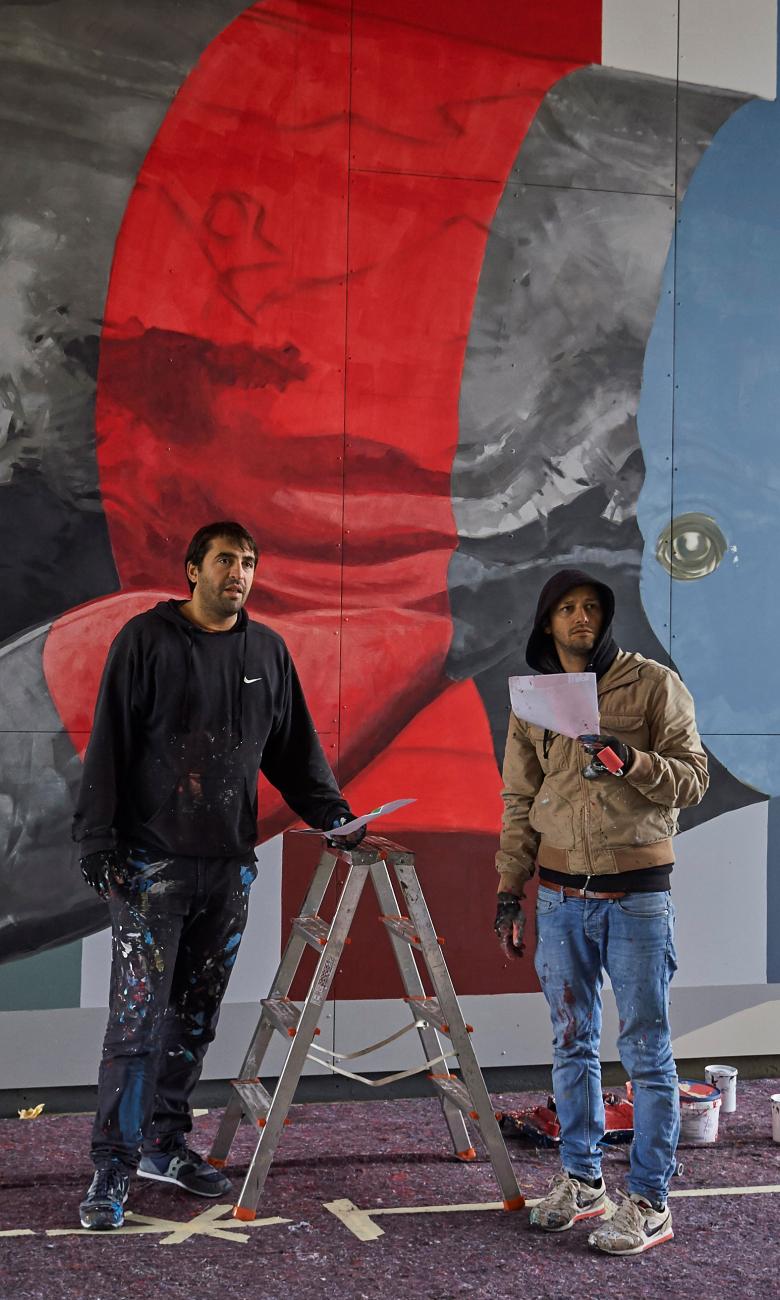Walking tour of Madrid in search of Swiss-Italian art and architecture
To mark the Week of the Italian Language in the World, the Swiss embassy in Madrid invites us on a walking tour of central Madrid in search of traces left by Swiss Italians, past and present, in the city. Just a few minutes from the embassy we stop in front of a street mural created by artists from the Italian-speaking canton of Ticino.
It sometimes happens that you visit a city for the first time and immediately feel at home. That's certainly how a number of Swiss embassy staff feel about Madrid. Flags, statues and the emblem of Madrid depicting a gluttonous bear leaning against a strawberry tree remind us of the mascot of Bern, the bear. But the bears featured in the street art mural on Calle de Augusto Figueroa take us all the way to Ticino. Our guides are Vanessa Reichmuth Pozo and Alberto Giovanetti, who work in the Swiss embassy for Spain and Andorra.
Ticinese art in the streets of Madrid
Alongside her job in the Swiss defence attaché's office at the embassy, Vanessa Reichmuth Pozo works as an official tourist guide for the City of Madrid. She was born in Madrid and knows the city like the back of her hand. Last year, she added a stop 'made in Ticino' to her multilingual guided tours of the city. "The Offset mural was created by two artists from Ticino for the Urvanity 2020 Art Fair, which showcased the work of urban artists from around the world. They completed this street mural before the lockdown that shut down much of Spain in March 2020," explains Pozo.

Christian Rebecchi and Pablo Togni, aka Nevercrew, painted their first mural in Bellinzona in 1996. After numerous stops all over Europe and some 60 'urban interventions' later, they travelled to Madrid. Here they decided to paint six bears piled on top of each other, each smaller than the one below, with the smallest bear with a strawberry tree leaf on top of its nose. "The mural is a nod to the city's emblem which, like Bern's, goes back to medieval times. The bear symbolises the city's strength. The mural is also a cry from the heart against people's abuse of the urban environment in a way that upsets its balance with nature".
Alberto Giovanetti and Vanessa Reichmuth Pozo, staff members of the Swiss embassy in Madrid, are our guides on a visit to the Nevercrew mural.
Pozo's guided tours of Madrid are a unique way to discover the deep imprint left by Swiss artists and architects on the city. "We have, for example, the CaixaForum and BBVA building by Herzog & de Meuron, and an exhibition by the Swiss-Argentinean artist Vivian Suter that is now at the Reina Sofia museum," she notes.
But let's leave Calle de Augusto Figueroa and return to the Swiss embassy – where we hear the sounds of Spanish, French, German and even some verses from Dante's Inferno.
"Honour you bring, my lord, to art and learning. Inform me who these are – their honour great – who stand apart in some way from the rest." Alberto Giovanetti, science and culture counsellor at the embassy, is rehearsing his part in a marathon reading of the Divine Comedy organised by the Circolo delle Belle Arti in Madrid to mark the Week of the Italian Language in the World. This year's theme is Dante. Swiss Ambassador Hanspeter Mock will read Canto II of Inferno. Giovanetti will be reading Canto IV, in which Dante makes his way through limbo with Virgil, who introduces him to the classical poets. The tercets from the Divine Comedy will be read out loud in Dante's original Italian. "A group of Italian speakers working in Spanish institutions and the embassies of various other countries here in Madrid will take part in the reading," explains Giovanetti.
Of Swiss and Spanish origin, Giovanetti came to Madrid 10 years ago to do a degree in international relations. He has come to know and love the city since then. Giovanetti has spent much of his career promoting culture and dialogue, and particularly the Italian language – the third most widely spoken national language in Switzerland – to the Spanish public. The Swiss embassy in Spain and Andorra and the Swiss consulate general in Barcelona collaborate every year on events featuring personalities from the Italian-speaking part of Switzerland. "Last year we contributed to a webinar on Gianni Rodari with Letizia Bolzani of Il Folletto, a magazine published by the Swiss Institute for Children's and Youth Media in Bellinzona. 2020 was also the year Ticino designer Bruno Monguzzi was awarded a prize at the Madrid Design Festival. This summer the Compagnia Finzi Pasca took part in the Veranos de la Villa summer festival in Madrid," adds Giovanetti.
Clearly, in Spain, as in many other parts of the world, Swiss-Italians have made a mark, and they are adding to it year after year through their contributions to the fields of art and architecture. Swiss embassies around the world are a unique treasure trove of stories with Italian-speaking protagonists. Let's mark in our calendars the 2022 October edition of the Week of the Italian Language in the World, which is sure to offer new perspectives from around the world.
The original version of the text is in Italian.
Cover-Image: Dal Ticino a Madrid: l’opera “Offset” dei Nevercrew è stata realizzata in occasione della Urvanity 2020 Art Fair.
© Nevercrew
Portrait-Image: Christian Rebecchi e Pablo Togni all’opera ad Aalborf, in Danimarca, nel 2018. Foto di Allan Toft. © Nevercrew




